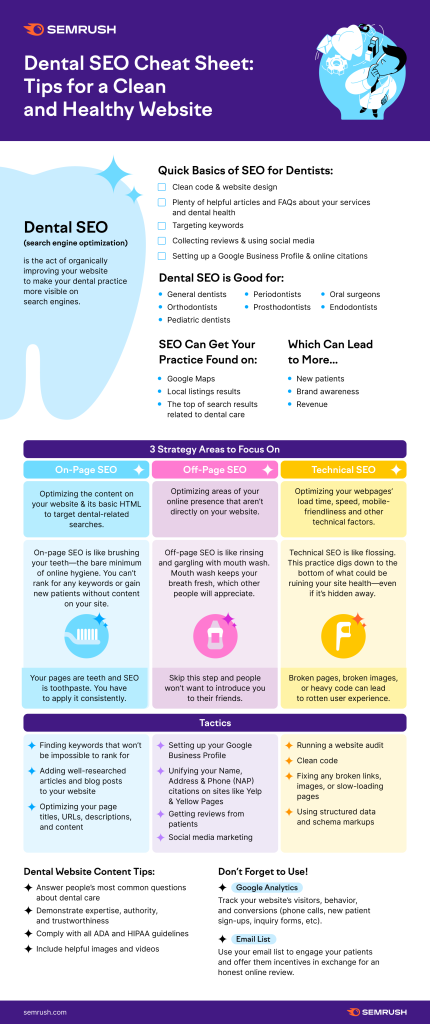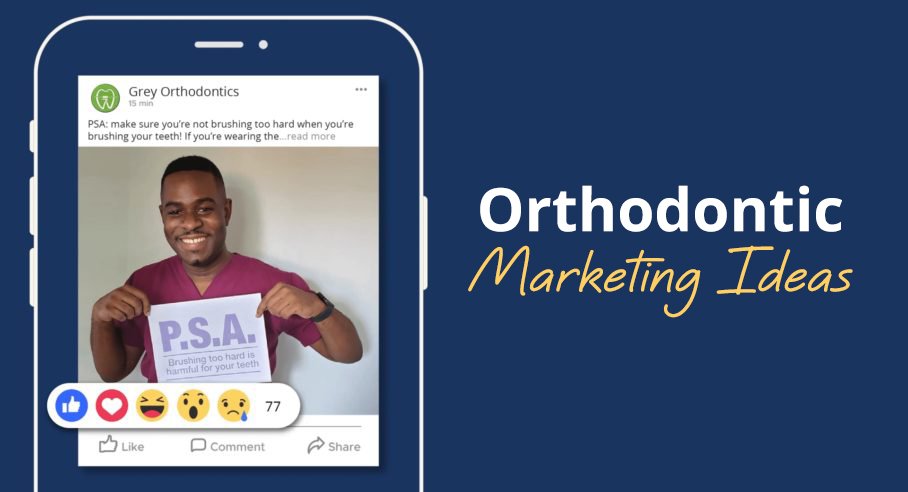Are you an orthodontist or dentist looking to boost your online visibility? Look no further than orthodontic SEO. By implementing effective search engine optimization strategies, you can improve your website’s ranking on search engine results pages and attract more potential patients. In this article, we will explore the importance of orthodontic SEO and how it can help your practice thrive in the digital age. Whether you’re located in Philadelphia or anywhere else, Ortho Advertising has the expertise to drive traffic to your website and increase your online presence.
Benefits of Orthodontic SEO

Get Started With Orthodontic SEO Today
Increased visibility in search engine results
Implementing orthodontic SEO strategies can greatly increase the visibility of your orthodontic practice in search engine results. When potential patients search for orthodontic services in your area, having a well-optimized website can ensure that your practice appears at the top of the search results. This increased visibility can lead to more organic traffic to your website, ultimately resulting in a higher number of patient inquiries.
Higher website traffic and patient inquiries
Orthodontic SEO techniques can significantly boost the amount of traffic your website receives. By optimizing your website for relevant keywords and search terms, you can attract more visitors who are actively seeking orthodontic services. This targeted traffic is more likely to convert into patient inquiries, allowing you to grow your practice and increase your patient base.
Improved online reputation and credibility
A strong online presence is essential for establishing and maintaining a positive reputation in the orthodontic industry. By implementing effective SEO strategies, you can improve your online reputation and credibility. When your website ranks higher in search engine results, potential patients perceive your practice as more trustworthy and credible. This can lead to increased patient trust and a higher likelihood of patients choosing your practice over your competitors.
Stand out from competitors
In today’s competitive orthodontic market, it is crucial to stand out from your competitors. Orthodontic SEO can give you a competitive edge by helping your website rank higher in search engine results. When your website appears at the top of the search results, potential patients are more likely to click on your website and choose your practice. By implementing effective SEO strategies, you can differentiate yourself from your competitors and attract more patients to your orthodontic practice.
Key Elements of Orthodontic SEO
Keyword research and optimization
Keyword research is a fundamental aspect of any successful orthodontic SEO strategy. By identifying relevant keywords that potential patients are using to search for orthodontic services, you can optimize your website content accordingly. This involves strategically incorporating these keywords into your website’s title tags, meta descriptions, headers, and content. By optimizing your website for the right keywords, you can increase your chances of appearing in relevant search results and attracting your target audience.
On-page optimization
On-page optimization involves optimizing the elements on your website to improve its visibility in search engine results. This includes optimizing the website structure and navigation to help search engine crawlers index your website effectively. Creating unique and descriptive page titles and meta descriptions helps search engines understand the content of each page. Proper use of heading tags, such as H1, H2, and H3, helps emphasize important keywords within your content. Organizing content with bullet points and subheadings makes it easier for both search engines and users to navigate and understand your website.
Technical optimization
Technical optimization focuses on ensuring that your website is technically sound and optimized for search engines and users. This includes optimizing website loading speed, as slow-loading websites can negatively impact user experience and search engine rankings. An effective technical optimization strategy also involves optimizing the URL structure of your website, making it more user-friendly and search engine friendly. Integrating a mobile-friendly design is crucial, considering the increasing number of users accessing websites on mobile devices. Conducting regular tests to ensure website usability and a positive user experience is also an important aspect of technical optimization.
Link building
Link building is a crucial component of orthodontic SEO that involves acquiring quality backlinks to your website. Backlinks are like votes of confidence from other websites, indicating to search engines that your website is trustworthy and authoritative. Creating high-quality backlinks can be achieved through various methods, such as guest blogging and content collaboration with reputable websites in the dental and orthodontic industry. Additionally, linking to reputable industry websites and utilizing social media platforms for link building can greatly enhance your website’s visibility and reputation.

Improve Your Online Visibility With Orthodontic SEO
Local SEO
Local SEO is essential for orthodontic practices targeting a specific geographical area. Optimizing your practice’s Google My Business profile ensures that your practice appears prominently in local search results. Creating location-specific landing pages on your website can help target specific areas and optimize for locally relevant keywords. Obtaining online reviews and ratings from satisfied patients can boost your practice’s credibility and visibility in local search results. Participating in local directories and implementing local schema markup further enhance your chances of appearing in localized searches.
Keyword Research and Optimization
Identifying relevant keywords
Effective keyword research begins by identifying the most relevant keywords and search terms that potential patients are using to find orthodontic services. This involves understanding your target audience and conducting keyword research using tools like Google Keyword Planner. By identifying keywords with high search volume and low competition, you can optimize your website content to rank higher for these keywords.
Analyzing keyword competition
Analyzing keyword competition is an important step in the keyword optimization process. By evaluating the competitiveness of specific keywords, you can identify opportunities to target less competitive keywords that still have a significant search volume. This allows you to optimize your website for keywords that have a higher likelihood of ranking well and attracting targeted traffic.
Optimizing website content with keywords
Once you have identified relevant keywords, it is important to strategically incorporate them into your website’s content. This includes optimizing the title tags, meta descriptions, headers, and body copy to include the targeted keywords. However, it is essential to ensure that the keyword usage is natural and does not compromise the readability and user experience of your website.
Using long-tail keywords
Long-tail keywords are longer and more specific keyword phrases that potential patients may use when searching for orthodontic services. While they may have lower search volume, they often have higher intent and conversion rates. By optimizing your website for relevant long-tail keywords, you can attract highly targeted traffic that is more likely to convert into patient inquiries.
On-Page Optimization
Optimizing website structure and navigation
Optimizing your website structure and navigation is crucial for both search engines and users. A well-structured website makes it easier for search engine crawlers to understand and index your content. It also enhances user experience by allowing visitors to navigate your website effortlessly. Ensure that your website has a clear and logical hierarchy, with important pages easily accessible from the homepage.
Creating unique and descriptive page titles
Creating unique and descriptive page titles is essential for both SEO and user experience. Page titles not only help search engines understand the content of a specific page but also influence click-through rates from search engine results. Each page on your website should have a distinct and compelling title that accurately reflects its content and targets relevant keywords.
Writing quality meta descriptions
Meta descriptions are brief summaries that appear below the page title in search engine results. Although meta descriptions do not directly impact search engine rankings, they play a crucial role in attracting clicks from potential patients. Well-crafted meta descriptions should be unique for each page, concise, informative, and include relevant keywords to entice users to click on your website.

Using heading tags appropriately
Heading tags, such as H1, H2, and H3, not only help structure your content but also provide search engines with important cues about the relevance and hierarchy of the information on the page. Proper use of heading tags can help emphasize important keywords and sections within your content. Ensure that you use heading tags appropriately and consistently throughout your website.
Organizing content with bullet points and subheadings
Organizing your content with bullet points and subheadings makes it easier for both search engines and users to understand and navigate your website. Bullet points help break down information into easily digestible chunks, while subheadings create logical sections within your content. This not only enhances readability but also improves the overall user experience, increasing the chances of visitors staying on your website for longer periods.
Technical Optimization
Ensuring fast and responsive website design
A fast and responsive website design is crucial for both user experience and search engine rankings. Slow-loading websites can lead to high bounce rates and lower search engine rankings. Ensure that your website is optimized for speed by minimizing file sizes, compressing images, and utilizing caching techniques. Additionally, implementing a responsive design ensures that your website adapts and functions seamlessly across different devices and screen sizes.
Optimizing URL structure
Optimizing your website’s URL structure can improve its visibility in search engine results. Use descriptive and keyword-rich URLs that accurately reflect the content of each page. Avoid using long and convoluted URLs that are difficult for users and search engines to understand. Additionally, utilize hyphens to separate words in the URL to enhance readability and avoid using special characters or unnecessary parameters.
Enhancing website loading speed
Website loading speed is a critical factor in user experience and SEO. Slow-loading websites can frustrate visitors and negatively impact search engine rankings. Optimize your website’s loading speed by compressing images, minifying CSS and JavaScript files, and utilizing content delivery networks (CDNs). Regularly monitor and test your website’s loading speed to identify and address any performance issues.
Integrating mobile-friendly design
With an increasing number of users accessing websites on mobile devices, having a mobile-friendly design is essential. Implement a responsive design that ensures your website’s layout and functionality adapt to various screen sizes seamlessly. This not only improves the user experience but also helps your website rank higher in mobile search results. Mobile-friendly websites are also more likely to be recommended and shared by users, enhancing your overall online visibility.
Testing website usability and user experience
Regularly testing your website’s usability and user experience is crucial for identifying any potential issues that may hinder its performance. Conduct user testing to gather feedback on the ease of navigation, content accessibility, and overall functionality of your website. Utilize heatmaps and analytics tools to gain insights into visitor behavior and identify areas for improvement. By continuously optimizing your website’s usability, you can provide an exceptional user experience and increase the likelihood of attracting and retaining patients.
Link Building
Creating high-quality backlinks
Creating high-quality backlinks is a fundamental aspect of off-page SEO. Backlinks from reputable and authoritative websites indicate to search engines that your website is trustworthy and relevant. Focus on acquiring backlinks from websites that are relevant to the orthodontic industry, such as dental associations, professional organizations, and industry influencers. Ensure that the backlinks are natural and relevant to your content, as search engines can penalize websites with spammy or low-quality backlinks.

Guest blogging and content collaboration
Guest blogging and content collaboration are effective strategies for acquiring quality backlinks and increasing your online visibility. Reach out to relevant dental and orthodontic websites and offer to write informative and valuable guest posts. By providing insightful content, you can establish credibility and attract backlinks from reputable sources. Collaborating with industry experts and influencers to create content can also help broaden your reach and attract a larger audience.
Linking to reputable industry websites
Linking to reputable industry websites can further enhance your website’s credibility and visibility. When appropriate, include outbound links to authoritative sources that support and validate your content. This not only provides additional value to your visitors but also signals to search engines that your website is a trusted resource within the orthodontic industry. Be selective and thoughtful when linking to external websites, ensuring that they are relevant and reliable sources of information.
Utilizing social media platforms for link building
Social media platforms provide valuable opportunities for link building and increasing your online visibility. Share your website’s content on social media and encourage others to share and link back to your content. Engage with your social media followers and respond to their comments and inquiries promptly. Actively participate in relevant discussions and communities within your industry to build relationships and gain visibility. Additionally, consider utilizing paid social media advertising to reach a wider audience and promote your content.
Local SEO
Optimizing Google My Business profile
Optimizing your Google My Business profile is crucial for local SEO. Claim and verify your orthodontic practice’s profile on Google My Business, ensuring that your business information is accurate and up to date. Add relevant keywords and descriptions to your profile, enabling your practice to appear in local search results. Encourage satisfied patients to leave reviews and ratings on your Google My Business page, as positive reviews can significantly boost your local visibility.
Creating location-specific landing pages
Creating location-specific landing pages on your website can help target specific areas and optimize for locally relevant keywords. Include location-specific information such as addresses, phone numbers, and directions to your orthodontic practice. Ensure that your content is unique and tailored to each location, addressing the specific needs and interests of potential patients in those areas. Optimizing these landing pages with local keywords and search terms can significantly improve your chances of appearing in local search results.
Obtaining online reviews and ratings
Online reviews and ratings play a significant role in local SEO and can greatly influence patients’ decisions. Encourage your satisfied patients to leave positive reviews and ratings on various review platforms such as Google, Yelp, and Healthgrades. Respond to both positive and negative reviews in a professional and timely manner, demonstrating your commitment to patient satisfaction. Regularly monitor and manage your online reputation to ensure that your practice is perceived as reputable and trustworthy.
Participating in local directories
Participating in local directories can increase your practice’s visibility in local search results. Submit your orthodontic practice’s information to reputable local directories such as Yelp, Yellow Pages, and Bing Places. Ensure that your practice’s name, address, and phone number (NAP) are consistent across all directories, as inconsistent NAP information can negatively impact your local search rankings. Additionally, include relevant keywords and descriptions in your directory listings to optimize your visibility.
Implementing local schema markup
Implementing local schema markup on your website is an effective way to communicate your practice’s location and contact information to search engines. Schema markup provides search engines with structured data that can enhance how your website is displayed in search results. By including details such as your practice’s address, phone number, and operating hours in your schema markup, you can improve your chances of appearing prominently in local search results.
Content Marketing for Orthodontic SEO

Producing informative and engaging blog posts
Producing informative and engaging blog posts is an excellent way to attract organic traffic to your website and demonstrate your expertise in the orthodontic field. Regularly publish blog posts that provide valuable information and answer common questions that potential patients may have. Ensure that your blog posts are well-optimized for relevant keywords and include high-quality images and multimedia elements to enhance the overall user experience.
Sharing educational videos and tutorials
Incorporating videos and tutorials into your content marketing strategy can greatly enhance your orthodontic SEO efforts. Create educational videos that showcase various orthodontic procedures and provide helpful tips for maintaining oral health. Share these videos on your website and social media platforms to attract and engage with a wider audience. Videos and tutorials not only provide valuable information but also allow potential patients to visualize the services you offer, increasing the likelihood of them choosing your practice.
Using infographics to visually present information
Infographics are visually appealing and shareable content formats that can effectively communicate complex information. Create informative infographics that visually present orthodontic concepts, treatment processes, and oral care tips. Infographics are highly shareable on social media platforms, allowing your content to reach a larger audience and attract backlinks from other websites. When optimizing your infographics for SEO, ensure that they include relevant keywords and are properly labeled for search engines to understand their content.
Creating downloadable resources and guides
Creating downloadable resources and guides can provide additional value to your website visitors and establish your orthodontic practice as a trusted resource. Offer downloadable resources such as e-books, guides, and checklists that provide in-depth information on various orthodontic topics. Optimize these resources with relevant keywords and encourage visitors to download and share them. By offering valuable and downloadable content, you can attract more targeted traffic to your website and generate qualified leads.
Optimizing content for social media sharing
Optimize your website’s content to make it easy for visitors to share on social media platforms. Include social sharing buttons on your blog posts, videos, and other valuable content. By optimizing your content for social media sharing, you can leverage the power of social signals to increase your online visibility, attract more website traffic, and potentially earn valuable backlinks. Encourage social media sharing by creating engaging and shareable content that resonates with your target audience.
Social Media Marketing for Orthodontic SEO
Creating and managing social media profiles
Creating and managing social media profiles is crucial for maximizing your orthodontic practice’s online visibility and engaging with your target audience. Identify the social media platforms that are most popular among your target demographic and create profiles on those platforms. Optimize your profiles with relevant keywords and ensure that your practice’s branding is consistent across all social media platforms. Regularly update and monitor your social media profiles to maintain an active and engaging presence.
Engaging with followers and potential patients
Engaging with your social media followers and potential patients is an excellent way to build relationships, establish trust, and increase your practice’s visibility. Respond to comments, messages, and inquiries promptly and professionally. Use social media platforms to provide valuable information, answer questions, and address concerns. By actively engaging with your audience, you can foster a sense of community and build a loyal following.
Sharing educational and entertaining content
Sharing educational and entertaining content on social media can help position your orthodontic practice as an industry authority and attract a broader audience. Share informative articles, blog posts, videos, and infographics that provide valuable insights into orthodontic treatments and oral health care. Additionally, share entertaining content such as patient success stories, behind-the-scenes glimpses, and fun dental-related facts. Balancing educational and entertaining content on social media can help you engage with your audience and make your practice more approachable.
Running social media contests and promotions
Running social media contests and promotions can greatly increase your practice’s visibility and engagement on social media platforms. Encourage followers to participate in contests by offering prizes or discounts on orthodontic services. Promote these contests and promotions on your social media profiles to attract a wider audience and generate excitement. By running engaging and shareable contests, you can increase your social media following, attract new patients, and potentially earn valuable backlinks.
Utilizing paid advertising on social media platforms
Paid advertising on social media platforms can amplify your orthodontic SEO efforts and increase your practice’s visibility to a targeted audience. Platforms like Facebook and Instagram offer various advertising options that allow you to narrow down your audience based on demographics, interests, and behaviors. By strategically targeting your ads, you can reach potential patients who are actively seeking orthodontic services. When utilizing paid advertising, ensure that your ad copy, images, and landing pages are optimized for maximum conversions.
Measuring and Analyzing Orthodontic SEO Success
Monitoring website traffic and rankings
Monitoring your website traffic and search engine rankings is crucial for evaluating the success of your orthodontic SEO efforts. Utilize tools like Google Analytics to track the number of visitors your website receives, the sources of your website traffic, and the keywords that are driving the most traffic. Regularly monitor your website’s rankings for relevant keywords to assess your visibility in search engine results and identify any areas for improvement.
Tracking keyword performance
Tracking the performance of your targeted keywords is essential for optimizing your orthodontic SEO strategy. Utilize keyword tracking tools to monitor how your keywords are ranking in search engine results. Evaluate the keywords that are driving the most traffic and conversions and identify any underperforming keywords that may require further optimization. By continuously tracking keyword performance, you can refine your SEO strategy and focus on targeting keywords that yield the best results.
Analyzing patient inquiries and conversions
Analyzing patient inquiries and conversions is key to understanding the effectiveness of your orthodontic SEO efforts in driving actual revenue for your practice. Track the number of patient inquiries generated from your website, focusing on metrics such as form submissions, phone calls, and appointment requests. Monitor the conversion rate of these inquiries to assess the quality of the leads generated through your SEO strategy. By analyzing patient inquiries and conversions, you can make data-driven decisions to optimize your SEO and maximize your practice’s revenue.
Utilizing Google Analytics and other SEO tools
Google Analytics and other SEO tools provide valuable insights into the performance of your orthodontic SEO efforts. Analyze data such as website traffic, user behavior, bounce rates, and conversion rates to identify areas for improvement. Utilize SEO tools to conduct in-depth keyword research, track backlinks, and monitor your website’s technical performance. By leveraging these tools, you can gain a comprehensive understanding of your orthodontic SEO performance and make informed decisions to optimize your strategy.
Adjusting strategies based on data analysis
Data analysis is crucial for optimizing your orthodontic SEO strategy. Continuously analyze the data gathered from tools like Google Analytics and keyword tracking tools to identify trends, assess the impact of your SEO efforts, and make data-driven decisions. Adjust your strategies based on the insights gained from data analysis, focusing on optimizing for keywords that generate the most traffic and conversions. Regularly revisit and refine your SEO tactics to adapt to changes in search engine algorithms and the evolving needs of potential patients.

